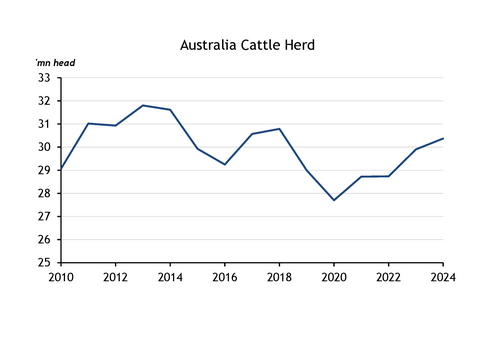Australia's total cattle herd grew to 30.4mn head in the 2023-24 financial year to 30 June, the Australian Bureau of Statistics (ABS) said today. But separate forecasts indicate numbers could fall over the next few years.
Australia's cattle herd grew by about 2pc on the year to 30.4mn head as of 30 June 2024. Beef cattle represents about 93pc of the total herd.
Queensland's beef numbers grew by 3pc on the year to 13.6mn head as of 30 June 2024 because of favourable seasonal conditions, accounting for around 45pc of Australia's total beef herd.
Herd numbers also increased in South Australia in the 2023-24 financial year, despite most of the state experiencing below or very much below average rainfall over the year, particularly in the southeast of the state where the cattle numbers are concentrated.
But the herd is forecast to shrink to 30.1mn head as of 30 June 2025, before declining to 28.8mn head as of 30 June 2027, because of higher rates of female slaughter, according to separate forecasts by Meat and Livestock Australia released in March.
| Australian cattle numbers | 000 head | ||
| FY 23-24 | FY 22-23 | % ± y-o-y | |
| New South Wales* | 6,197 | 6,134 | 1.0 |
| Victoria | 4,166 | 4,146 | 0.5 |
| Queensland | 13,587 | 13,238 | 2.6 |
| South Australia | 1,245 | 1,214 | 2.5 |
| Western Australia | 2,363 | 2,383 | -0.8 |
| Tasmania | 880 | 861 | 2.2 |
| Northern Territory | 1,934 | 1,925 | 0.5 |
| Australia | 30,373 | 29,902 | 1.6 |
| *Includes Australian Capital Territory | |||
| Source:ABS | |||



